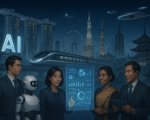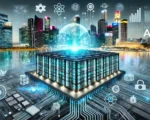
The perception of nuclear power has been shaped by historical accidents and a lack of public understanding of its advancements.
For decades, nuclear energy has been a source of both fascination and fear. From the Cold War-era anxieties of atomic bombs to high-profile disasters such as Chernobyl and Fukushima, the mere mention of nuclear power stirs deep-seated concerns about safety, environmental impact and long-term waste management.
However, as the world races toward an AI-driven future, the demand for reliable, low-carbon energy is pushing for a reassessment of nuclear power, particularly in APAC where next-generation nuclear technology is emerging as a key enabler of energy-intensive data centres.
Nuclear power remains one of the safest energy sources per unit of electricity produced, with far fewer fatalities compared to coal, oil, and even hydropower. Modern reactors incorporate passive safety mechanisms that significantly reduce the risk of meltdowns, while advancements in waste management enable more sustainable solutions.
Despite these developments, public hesitation persists. A major challenge for governments and companies promoting nuclear energy is overcoming decades of misinformation and fear. The pressing need for clean, abundant energy, however, is changing the narrative, as rapid urbanisation and increasing AI adoption propel electricity demand to unprecedented levels.
Matthew Oostveen, CTO for APAC and Japan at Pure Storage, believes that nuclear energy could play a pivotal role. Deeptech Times gathered his insights on the viability of nuclear power for AI, its ethical implications, and the potential of emerging technologies like small modular reactors (SMRs) in this feature.

IMAGE: Pure Storage
A question of viability
AI systems, particularly energy-intensive ones like large-scale data centres, are increasingly challenging conventional energy sources. While renewable energy options like wind and solar are lauded for their affordability, Oostveen pointed out that their intermittent nature leaves room for alternatives.
“The answer depends on where in the world the nuclear plant is located,” said Oostveen. “In jurisdictions with pre-existing approvals for nuclear energy, the time to produce energy can be short enough to make it a viable alternative. But in locations new to nuclear power, complex licensing processes could delay deployment.”
Cost, too, plays a decisive role. While renewable energy remains the cheapest option, the high capital costs of nuclear—including advanced SMRs—can make it less competitive.
“In contrast, the capital cost of nuclear energy, even SMRs, is high as compared with other energy production methods,” he said.
The ethical dimension
Beyond economics, Oostveen raised critical ethical questions about nuclear energy expansion. He cautioned that decisions made today would leave an indelible impact on future generations.
“The responsibility to manage long-lived radioactive waste will fall to those who have no say in current policymaking,” he said. “This raises a moral question: Are we simply shifting the problem to the next generation?”
“The decision to pursue an atomic power path must take into account the responsibility we have to future generations, who will inherit the burden of managing long-lived radioactive waste. Wind and solar energy, on the other hand, do not carry the same burden. Decisions made today can be more easily reversed in the future if better alternative energy sources become available.”
Transforming remote data centres
One area where nuclear energy, particularly SMRs, could shine is in decarbonising data centres located in remote or resource-constrained regions. These compact reactors, often pre-fabricated in factories, are designed for low maintenance and can operate for up to seven years before requiring refueling.
“For data centres in areas with limited water or land access, SMRs could be transformational,” said Oostveen. Their scalable and low-maintenance nature makes them particularly appealing for supporting the burgeoning AI ecosystem.
Rebuilding public trust
A significant hurdle to nuclear adoption lies in public perception. Misinformation, rooted in nuclear energy’s early association with weaponry, continues to hinder its acceptance.
“Few technologies are as tarnished by myth as nuclear energy,” Oostveen lamented. “Education and scientific literacy are crucial to overcoming this barrier.”
He called for collaboration between industry and government to rebuild trust through transparent communication and public education.
“Guiding the public toward a rational understanding of nuclear power’s potential is a significant challenge but a necessary one,” he asserted.
Achieving net-zero goals
With global data centre expansion outpacing renewable energy production, Oostveen argued that nuclear power could fill the gap in achieving net-zero emissions.
“Small-scale nuclear power can generate reliable, scalable, and low-maintenance “green energy” to meet the growing demands of AI and other emerging technologies,” he explained.
In the right context and location, nuclear energy could serve as a cornerstone for a sustainable AI-powered future, bridging the divide between energy demands and environmental responsibility.
As the world grapples with the dual challenges of advancing AI and combating climate change, Oostveen’s insights underscore the importance of a diversified energy strategy. While nuclear energy presents ethical and logistical hurdles, its potential to provide reliable, clean energy makes it a compelling candidate for powering the next wave of technological innovation.
Where are we now
The APAC region is moving quickly toward the adoption of next-generation nuclear technology.
China is at the forefront, with its aggressive nuclear expansion strategy, while other countries like Japan and South Korea are reinvigorating their nuclear industries after years of stagnation.
Southeast Asian nations are also showing increased interest in nuclear energy as they seek reliable and sustainable power sources for their digital economies.
However, challenges remain. Regulatory frameworks, public perception and geopolitical considerations all play a role in shaping the nuclear energy landscape. Ensuring transparency, safety and international collaboration will be critical in accelerating the adoption of nuclear power in the region.
As AI continues to develop and mature, the need for high-density, low-carbon energy sources will only grow. Next-generation nuclear technology, including advanced fission reactors and the long-term promise of fusion, is poised to play a crucial role in powering the AI-driven future.
While challenges remain, the momentum in APAC suggests that nuclear energy will be a cornerstone of sustainable growth, helping nations balance economic expansion with environmental responsibility. Overcoming fear with education and innovation is key to unlocking the full potential of nuclear energy in the 21st century.
Good to know facts
Fusion vs. fission: A crucial distinction
The conversation around next-generation nuclear energy often involves two fundamental processes: fission and fusion.
Most of today’s nuclear reactors operate on fission, where heavy atoms like uranium or plutonium are split to release energy. This method is highly efficient but generates radioactive waste that requires careful handling.
Fusion, on the other hand, is the process that powers the sun. It involves fusing lighter elements like hydrogen into helium, releasing immense energy without long-lived radioactive waste. The challenge, however, lies in sustaining the extreme temperatures and pressures needed to maintain fusion reactions. While projects like ITER in France and China’s EAST (Experimental Advanced Superconducting Tokamak) are making strides in fusion research, commercial fusion power remains at least a decade or two away.
China’s nuclear innovation: A 15-year lead over the U.S.
China has established itself as a dominant force in nuclear innovation, boasting a nuclear development programme nearly 15 years ahead of the United States. Through aggressive state-backed funding, advanced research, and fast-tracked regulatory approvals, China is deploying cutting-edge reactor designs at a pace unmatched by the West.
One of China’s most notable advancements is its high-temperature gas-cooled reactor (HTGR), which is designed to be inherently safe and highly efficient. Additionally, China has been making rapid progress in molten salt reactors (MSRs), a technology that offers enhanced safety features and the ability to use thorium as fuel, a more abundant and potentially less hazardous alternative to uranium.
The rise of SMRs
Unlike traditional large-scale reactors, SMRs are compact, factory-built, and scalable. Their smaller size allows them to be deployed in remote locations, making them ideal for powering off-grid AI data centres, industrial operations, and even floating nuclear power plants.
China has already begun constructing its first commercial SMR, the Linglong One, while Japan and South Korea are actively developing their own designs. Singapore, Indonesia and the Philippines are also exploring SMRs as a viable option for meeting their growing energy needs.
















